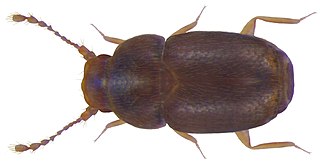
Beetles are insects that form the order Coleoptera, in the superorder Holometabola. Their front pair of wings are hardened into wing-cases, elytra, distinguishing them from most other insects. The Coleoptera, with about 400,000 described species, is the largest of all orders, constituting almost 40% of described insects and 25% of all known animal species; new species are discovered frequently, with estimates suggesting that there are between 0.9 and 2.1 million total species. However, the number of beetle species is challenged by the number of species in dipterans (flies) and hymenopterans (wasps).

Myxophaga is the second-smallest suborder of the Coleoptera after Archostemata, consisting of roughly 65 species of small to minute beetles in four families. The members of this suborder are aquatic and semiaquatic, and feed on algae.

Staphylinoidea is a superfamily of beetles. It is a very large and diverse group with worldwide distribution.

The titan beetle is a Neotropical longhorn beetle, the sole species in the genus Titanus, and one of the largest known beetles, as well as one of the largest known insects, at over 170 mm (6.7 in) in length. Adult titan beetles only live for a few weeks, and protect themselves from predators with their sharp spines and powerful jaws.

Macrodontia cervicornis, also known as the sabertooth longhorn beetle, is one of the largest beetles, if one allows for the enormous mandibles of the males, from which it derives both of the names in its binomen: Macrodontia means "long tooth", and cervicornis means "deer antler". Measurements of insect length normally exclude legs, jaws, or horns, but if jaws are included, the longest known specimen of M. cervicornis is 17.7 cm; the longest known specimen of Dynastes hercules, a beetle species with enormous horns, is 17.5 cm, and the longest known beetle excluding either jaws or horns is Titanus giganteus, at 16.7 cm.

Ptiliidae is a family of very tiny beetles with a cosmopolitan distribution. They are colloquially called featherwing beetles, because the hindwings are narrow and feathery.
The smallest organisms found on Earth can be determined according to various aspects of organism size, including volume, mass, height, length, or genome size.

Baranowskiella ehnstromi is the smallest known beetle in Europe. It lives only in the pores of the bracket fungus Phellinus conchatus, which grows on Salix caprea, and Phellinus punctatus, which grows on various deciduous trees. Its length is ca. 0.45–0.55 millimetres (0.018–0.022 in) and its width about 0.1 millimetres (0.0039 in).

Pteryx is a genus of beetles that is typically found in northern bogs in the Northern Hemisphere. They belong to the family Ptiliidae which is referred to as feather-winged beetles as the hindwings are narrow and feather-like. Like most of the rest of the family, Pteryx are very small and live in rotting vegetative matter. They prefer rotting wood and are generally found under the bark of rotting logs or stumps.

Megaphragma is a genus of wasp in the family Trichogrammatidae. It contains some of the smallest known insects, Megaphragma caribea and Megaphragma mymaripenne, which are roughly the same size as some unicellular protozoans.

Gelae is a genus of round fungus beetles belonging to the family Leiodidae. The beetles are found in different parts of Central and North America. They are small and rounded, feeding on slime moulds. They were originally placed in the genus Agathidium following the discovery of the first species, G. cognatum, in 1878. The taxonomic position was revised with description of new species in 2004 by American entomologists Kelly B. Miller and Quentin D. Wheeler. Upon creation of the new genus, the five new species are Gelae baen, G. belae, G. donut, G. fish, and G. rol.
Discheramocephalus brucei is a species of feather-winged beetle, the smallest beetles on earth, first found in Cameroon.
Discheramocephalus elisabethae is a species of feather-winged beetle, the smallest beetles on earth, first found in Cameroon.
Discheramocephalus mikaeli is a species of feather-winged beetle, the smallest beetles on earth, first found in Tanzania.
Discheramocephalus stewarti is a species of feather-winged beetle, the smallest beetles on earth, first found in Bolivia.
Discheramocephalus jarmilae is a species of feather-winged beetle, the smallest beetles on earth, first found in Bolivia.
Discheramocephalus is a genus of feather-winged beetles, the smallest beetles on earth, first found in Cameroon. It was originally described in 2007 as a monotypic genus. Six additional species were added in 2008, and two were added in 2013.
Discheramocephalus semisulcatus is a species of feather-winged beetle, the smallest beetles on earth.

Nephanes titan is a beetle from the Ptiliidae family of dwarf beetles. N. titan is notable for its exceptionally small body and simple nervous system. With an average maximum body length of only a few hundred micrometers, the beetle is one of the smallest non-parasitic insects in the world.











